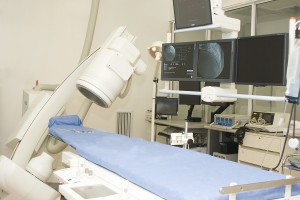 Cardiac catheterisation allows Dr Flood to identify the location and degree of any blockages in your coronary arteries.
Cardiac catheterisation allows Dr Flood to identify the location and degree of any blockages in your coronary arteries.
An Overview of the Procedure
Under local anaesthetic, your cardiologist inserts a long, thin tube into a blood vessel (usually in the groin). The tube is then gently directed to the heart and to the origin of the coronary arteries. X-rays are taken after contrast is injected into the coronary artery. This contrast is seen by the x-ray as a black line. Your cardiologist is looking for a disruption of the black line, which may signify an area of plaque build-up inside the wall of the artery.
At the same time, contrast is injected into the heart’s pumping chambers. This is done in order to see how well the heart muscle and valves are working. Pressure measurements are also taken at this time.
Preparing for the Procedure – What do you need to do?
You must attend the Hospital fasted (no food or drink for four hours prior to the test). You may drink a little water to take your medications.
You will be given a mild sedative to help you relax.
Catheterisation – What happens?
- You will be taken into the ‘Cath Lab’ on a trolley, and then moved onto the X-Ray table.
- You will have electrodes placed on your chest. Your groin will be swabbed with antiseptic and then your body covered with drapes.
- Your cardiologist will inject your groin with local anaesthetic. This will numb the area. Your cardiologist will then insert a small catheter into your blood vessels.
- Your cardiologist will guide the catheter, via the blood vessels, to the heart. There will be several injections of the contrast via the catheter. The catheter may be moved around during the procedure in order to get different views of your heart and coronary arteries. It is normal to feel flushed all over the body when contrast is injected.
- During the catheterisation procedure you may be asked to breathe deeply and cough. You will be able to communicate with Your cardiologist through the procedure, however, due to the nature of the sedative, you may not recall much of what has occurred. You can expect this procedure to last up to an hour.
- At this time, your cardiologist will consider your needs in regards to Coronary Angioplasty and Stenting. If you are a candidate for Angioplasty and Stenting, Your cardiologist will discuss when this can be undertaken. Usually, this procedure will be completed directly after your angiogram. In some cases, you may have to come back to the hospital for the further procedure. See Coronary Angioplasty and Stenting.
- The catheter is removed and firm pressure is applied to the incision in your groin for approximately 10-30 minutes. You will be required to lie flat for 3 hours afterwards to allow the insertion point to begin to heal. The nursing staff will monitor your blood pressure, catheter site and symptoms during this time.
Results
Your cardiologist will discuss your findings with you after the procedure
When will you be discharged?
Most patients who have undergone Coronary Angiography will be discharged and released later the same day. See Angioplasty and Stenting for release after these procedures.
You may notice some bruising at the catheter insertion site as well as a hard lump. If you are concerned about any aspects of your recovery after discharge, you should follow the contact instructions given to you by the Hospital after the procedure.
‘Any surgical or invasive procedure carries risks. Before proceeding, you should seek a second opinion from an appropriately qualified health practitioner.’

